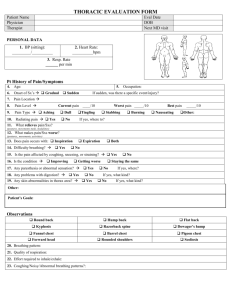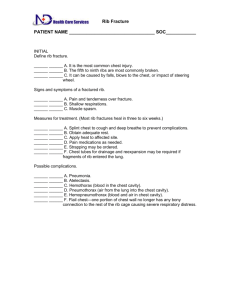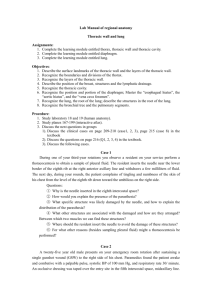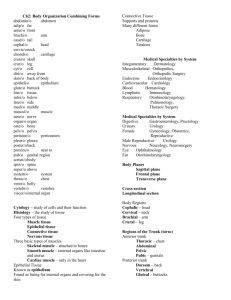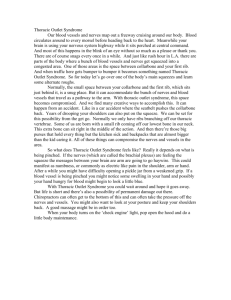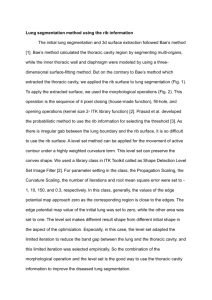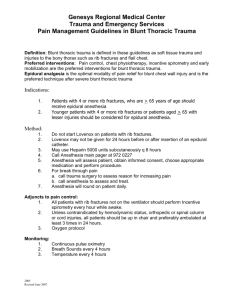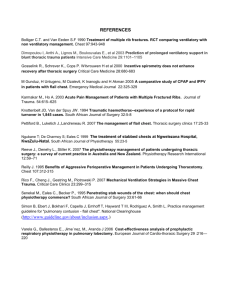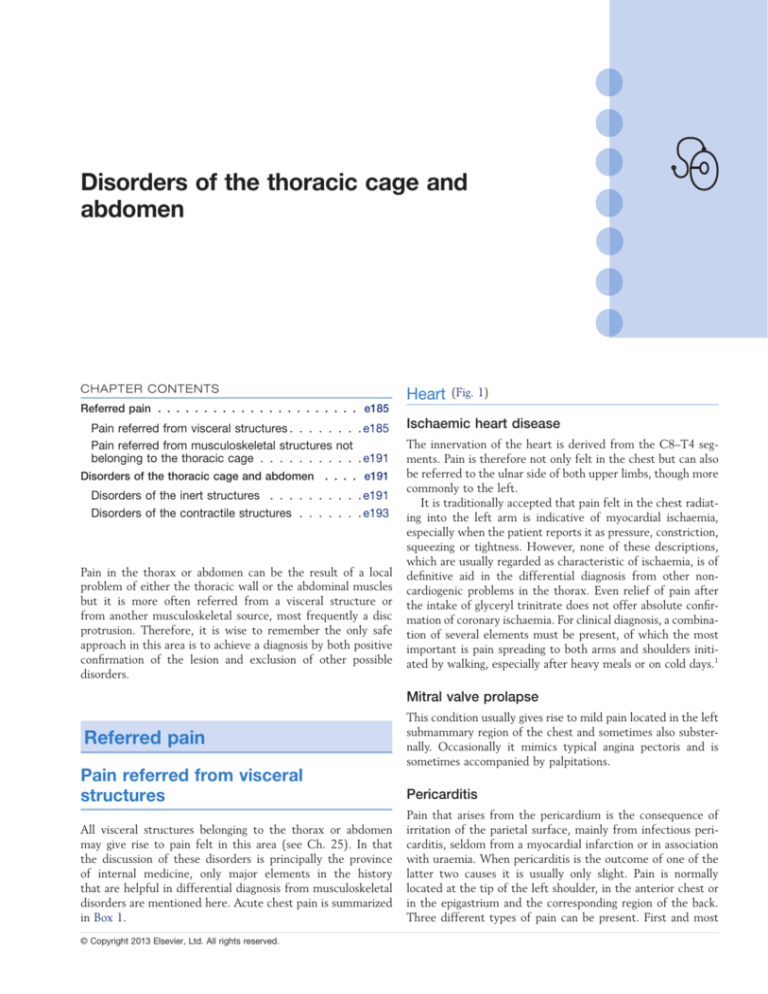
Disorders of the thoracic cage and
abdomen CHAPTER CONTENTS
Referred pain . . . . . . . . . . . . . . . . . . . . . . . e185
Pain referred from visceral structures . . . . . . . e185
Pain referred from musculoskeletal structures not
belonging to the thoracic cage . . . . . . . . . . . e191
Disorders of the thoracic cage and abdomen . . . . . e191
Disorders of the inert structures . . . . . . . . . . e191
Disorders of the contractile structures . . . . . . . e193
Pain in the thorax or abdomen can be the result of a local
problem of either the thoracic wall or the abdominal muscles
but it is more often referred from a visceral structure or
from another musculoskeletal source, most frequently a disc
protrusion. Therefore, it is wise to remember the only safe
approach in this area is to achieve a diagnosis by both positive
confirmation of the lesion and exclusion of other possible
disorders.
Heart
(Fig. 1)
Ischaemic heart disease
The innervation of the heart is derived from the C8–T4 segments. Pain is therefore not only felt in the chest but can also
be referred to the ulnar side of both upper limbs, though more
commonly to the left.
It is traditionally accepted that pain felt in the chest radiating into the left arm is indicative of myocardial ischaemia,
especially when the patient reports it as pressure, constriction,
squeezing or tightness. However, none of these descriptions,
which are usually regarded as characteristic of ischaemia, is of
definitive aid in the differential diagnosis from other noncardiogenic problems in the thorax. Even relief of pain after
the intake of glyceryl trinitrate does not offer absolute confirmation of coronary ischaemia. For clinical diagnosis, a combination of several elements must be present, of which the most
important is pain spreading to both arms and shoulders initiated by walking, especially after heavy meals or on cold days.1
Mitral valve prolapse
Referred pain
Pain referred from visceral
structures
All visceral structures belonging to the thorax or abdomen
may give rise to pain felt in this area (see Ch. 25). In that
the discussion of these disorders is principally the province
of internal medicine, only major elements in the history
that are helpful in differential diagnosis from musculoskeletal
disorders are mentioned here. Acute chest pain is summarized
in Box 1.
© Copyright 2013 Elsevier, Ltd. All rights reserved.
This condition usually gives rise to mild pain located in the left
submammary region of the chest and sometimes also substernally. Occasionally it mimics typical angina pectoris and is
sometimes accompanied by palpitations.
Pericarditis
Pain that arises from the pericardium is the consequence of
irritation of the parietal surface, mainly from infectious pericarditis, seldom from a myocardial infarction or in association
with uraemia. When pericarditis is the outcome of one of the
latter two causes it is usually only slight. Pain is normally
located at the tip of the left shoulder, in the anterior chest or
in the epigastrium and the corresponding region of the back.
Three different types of pain can be present. First and most
The Thoracic Spine
Box 1 Summary of acute chest pain
Severe chest pain of abrupt onset should arouse suspicion of:
Myocardial infarction
Dissecting aneurysm
Pneumothorax
Pulmonary embolus
Rupture of the oesophagus
Acute thoracic disc protrusion
When aortic dissection involves the vessels that supply the
spinal cord, neurological changes and even paraplegia may
result.3
Pleuritic pain
Pleuritic chest pain is a common symptom and has many
causes, which range from life-threatening to benign, selflimited conditions. Because neither the lungs nor the visceral
pleura have sensory innervation, pain is only present if the
parietal pleura is involved, which may occur in inflammation
or in pleural tumour. Invasion of the chest wall by a pulmonary
neoplasm also provokes pain.
Heart
Clinical presentation
Fig 1 • Referred pain in lesions of the heart.
obvious, but rarely encountered, is pain synchronous with the
heartbeat. Second is a steady, crushing substernal ache, indistinguishable from ischaemic heart disease. Third and most
common is pain caused by an associated localized pleurisy,
which is sharp, usually radiates to the interscapular area, is
aggravated by coughing, breathing, swallowing and recumbency, and is alleviated by leaning forward.2
Aorta
Pleuritic pain is localized to the area that is inflamed or along
predictable referred pain pathways. Parietal pleurae of the
outer rib cage and lateral aspect of each hemidiaphragm are
innervated by intercostal nerves. Pain is therefore referred to
their respective dermatomes. The central part of each hemidia­
phragm belongs to the C4 segment and therefore the pain is
referred to the ipsilateral neck or shoulder.
The classic feature is that forceful breathing movement,
such as taking a deep breath, coughing, or sneezing, exacerbates
the pain. Patients often relate that the pain is sharp and is made
worse with movement. Typically, they will assume a posture
that limits motion of the thorax. Movements of the trunk
which stretch the parietal pleura may increase the pain.
During auscultation the typical ‘friction rub’ is heard. The
normally smooth surfaces of the parietal and visceral pleurae
become rough with inflammation. As these surfaces rub against
one another, a rough scratching sound, or friction rub, may be
heard with inspiration and expiration. This friction rub is a
classic feature of pleurisy.
Aetiologies
Aneurysm of the thoracic aorta
Pneumonia
This is most frequently the result of arteriosclerosis but is rare
by comparison with the same condition below the diaphragm.
The majority of small aneurysms remain asymptomatic, but if
they expand a boring pain results, usually from displacement
of other visceral structures or erosion of adjacent bone. Compression of the recurrent nerve may result in hoarseness and
compression of the oesophagus in dysphagia. When acute pain
and dyspnoea supervene, this usually indicates that the aneurysm has ruptured, with a likely fatal outcome.
Although the clinical presentation of pneumonia may vary,
classically the patient is severely ill with high fever, pleuritic
pain and a dry cough.4
Dissecting aneurysm of the thoracic aorta
Pleural tumour
This is an exceptional cause of chest pain, occurring mainly in
hypertensive patients. The process usually starts suddenly in
the ascending aorta, giving rise to severe substernal or upper
abdominal pain. Radiation to the back is common and back
pain may sometimes be the only feature, expanding along the
area of dissection as it progresses distally. The patient often
describes the pain as tearing. In most cases, it is not changed
by posture or breathing.
Malignant mesothelioma is a diffuse tumour arising in the
pleura, peritoneum, or other serosal surface. The most frequent site of origin is the pleura (>90%), followed by peritoneum (6–10%), and only rarely other locations. Mesothelioma
is closely associated with asbestos exposure and has a long
latency (range 18–70). There is no efficient treatment and
the overall survival from malignant mesothelioma is poor
(8.8 months).5,6
e186
Carcinoma of the lung
In carcinoma of lung, pain is consequent upon involvement of
other structures such as the parietal pleura, the mediastinum
or the chest wall. Invasion of the chest wall may cause spasm
of the pectoralis major muscle, which subsequently leads to a
limitation of both passive and active elevation of the arm.
© Copyright 2013 Elsevier, Ltd. All rights reserved.
Disorders of the thoracic cage and abdomen Pleuritis
This is characterized by a sharp superficial and well-localized
pain in the chest, made worse by deep inspiration, coughing
and sneezing. Viral infection is one of the most common causes
of pleuritic pain.7 Viruses that have been linked as causative
agents include influenza, parainfluenza, coxsackieviruses, respiratory syncytial virus, mumps, cytomegalovirus, adenovirus,
and Epstein-Barr virus.8
Pulmonary embolism
Pulmonary embolism is the most common potentially lifethreatening cause, found in 5–20% of patients who present to
the emergency department with pleuritic pain.9,10
Predisposing factors for pulmonary embolism are: phlebo­
thrombosis in the legs, prior embolism or clot, cancer, immobilization, prolonged sitting (aeroplane), oestrogen use or
recent surgery.11
Symptoms and signs are mainly dependent on the extent
of the lesion. A small embolus may give rise to effort
dyspnoea, abnormal tiredness, syncope and occasionally to
cardiac arrhythmias. A medium-sized embolus may lead to
pulmonary infarction, so provoking dyspnoea and pleuritic
pain. In a massive pulmonary embolus, the patient complains
of severe central chest pain and suddenly shows features of
shock with pallor and sweating, marked tachynoea and tachycardia. Syncope with a dramatically reduced cardiac output
may follow. This is a medical emergency: death may follow
rapidly.
Acute pneumothorax
This is characterized by a sudden dyspnoea and unilateral pain
in the chest, radiating to the shoulder and arm on the affected
side and often described as a tearing sensation. Breathing
and activity increase the pain. The typical features of pneumothorax are tachycardia, hyperresonance on percussion and
decreased breath sounds on auscultation.
Superior sulcus tumour of the lung
(Pancoast’s tumour)
This warrants special attention because 90% of patients suffering from this disorder complain of musculoskeletal pain.12,13 It
is frequently mistaken for a shoulder lesion or even for thoracic
outlet syndrome, an error which leads to a delay in diagnosis
and treatment.14
The superior pulmonary sulcus is the groove in the lung
formed by the subclavian artery as it crosses the apex of the
lung. Because most apical tumours have some relation to the
sulcus, they are often called superior sulcus tumours. They
frequently involve the brachial plexus and the sympathetic
ganglia at the base of the neck and may destroy ribs and
vertebrae.
Pain around the shoulder, radiating down the arm and
towards the upper and lateral aspect of the chest is usual and
is often worse at night.
Orthopaedic clinical examination produces an unusual
pattern of clinical findings. There is often a complicated
mixture of cervical, shoulder and thoracic signs. Passive and
resisted movements of the cervical spine may be limited and/
or painful, the result of involvement of the scaleni and
© Copyright 2013 Elsevier, Ltd. All rights reserved.
Fig 2 • The clinical symptoms of a superior sulcus tumour of the
lung are produced by local extension into the chest wall, the base
of the neck and the neurovascular structures at the thoracic inlet.
sternocleidomastoid muscles. On examination of the shoulder
girdle, a restriction of both active and passive elevation of the
scapula may be present. More positive signs are detected
during examination of the shoulder.15 Both active and passive
elevations of the arm are limited because of spasm of the
pectoralis major muscle. Passive shoulder movements may be
considerably limited in a non-capsular way. Some resisted
movements are weak.
The neurological examination of the upper limb shows
weakness and atrophy of the muscles on which consequent is
extension of the tumour to the lower trunks of the brachialis
plexus (Fig. 2). The only abnormal finding during thoracic
examination is pain and limitation on lateral flexion towards
the unaffected side explained by putting the affected thoracic
wall under stretch.
The clinical picture of Pancoast’s tumour may be completed
by some typical findings that are caused by an ingrowth of
neurological and vascular structures at the apex of the lung.16
These include:
• Horner’s syndrome: this is characterized by an ipsilateral
slight ptosis of the upper lid, miosis of the pupil and
enophthalmos, together with decreased sweating on the
same side of the face. It is the outcome of involvement of
the ascending sympathetic pathway at the stellate ganglion
on the side of the tumour.17
• Hoarseness: this is the result of involvement of the
recurrent laryngeal nerve, which innervates the voice
cords. The hoarseness is unusual and unlike that caused by
local laryngeal problems.
• Oedema and discoloration of the arm: this occurs if the
subclavian vein is obliterated by the tumour.
All the symptoms and signs mentioned (summarized in Box 2),
either singly or in combination, call for careful clinical chest
e187
The Thoracic Spine
Oesophagus
Box 2 Superior sulcus tumour of the lung
Symptoms
Aggravating shoulder–arm pain (pulmonary symptoms)
Signs
Cervical spine: impaired movements and positive resisted tests
Shoulder girdle: impaired movement
Shoulder: limited arm elevation/noncapsular pattern/weak resisted
tests
Upper limb: weakness and atrophy
Thoracic spine: limited side flexion away from the affected side
Horner’s triad: ptosis, miosis, enophthalmos
Hoarseness
Oedema of the arm
Fig 3 • Referred pain in oesophageal lesions.
Diaphragm
examination followed by further investigation by chest radio­
graphy or other imaging methods.
Mediastinal problems
Acute mediastinitis
This is a rare inflammation, usually the result of perforation of
the oesophagus. The three causes are perforation of malignant
tumour, ingestion of caustics leading to necrosis and Mallory–
Weiss syndrome, in which vomiting without appropriate relaxation of the oesophagus causes a tear of the oesophagogastric
junction, often incomplete in thickness. There is very severe
substernal and central dorsal pain of abrupt onset, followed by
high fever and shock. Without treatment, it is rapidly fatal.
Mediastinal emphysema
This is usually the consequence of a ruptured pleural bleb or
a wound of the chest. Air spreads into the mediastinal tissues,
giving rise to sudden or more gradual substernal pain, sometimes radiating into the neck, shoulders and interscapular area.
Subcutaneous crepitus above the clavicle is pathognomonic for
the condition.
Fig 4 • Referred pain in diaphragmatic lesions.
Reflux oesophagitis
This is frequently due to a hernia of the stomach through the
diaphragmatic hiatus. Pain is felt around the xiphoid process,
can be very severe and may radiate to the rest of the sternum,
into the back and between the scapulae.18 Pyrosis or heartburn,
which begins if the patient lies down immediately after meals,
together with a burning sensation on eructation, are the most
typical symptoms.
Rupture of oesophagus
The symptoms are the same as those from acute mediastinitis
(see above).
Malignant tumour of the oesophagus
Mediastinal tumours
The initial symptoms are food lodgement at the site of the
tumour. Later there may be constant anterior or posterior
central chest pain, unrelated to eating and mainly the result of
extraoesophageal extension of the tumour. Total dysphagia may
follow, and remarkable weight loss over a short period of time
is an ominous sign.
These may give rise to anterior or posterior substernal pain,
which is usually steady, of mild severity and often worse at
night. Radiography reveals the diagnosis.
Diaphragm
Oesophagus
(Fig. 3)
Oesophageal spasm
This occurs suddenly and gives rise to substernal aching not
necessarily related to the intake of food. Relief is often obtained
by drinking hot water.
e188
(Fig. 4)
Diaphragmatic irritation
This can be the result of a subphrenic abscess or of air in the
abdomen after laparoscopy or laparotomy. Pain arising from
the central part of the diaphragm is referred to the base of the
neck and into the shoulders, mainly in the third and fourth
cervical segments. Pain originating from the peripheral part is
felt more at the lower thorax and in the upper abdomen.
© Copyright 2013 Elsevier, Ltd. All rights reserved.
Disorders of the thoracic cage and abdomen Stomach
Gallbladder
Fig 5 • Referred pain in gastric or duodenal lesions.
Fig 6 • Referred pain in lesions of the gallbladder.
Diaphragmatic hernia
occur, and epigastric pain is usually present but cannot be
distinguished from that from gastric or duodenal ulcer, because
it often responds to antacids or food.
This usually occurs due to displacement of the proximal part
of the stomach as a whole when the patient is prone or head
down or when intra-abdominal pressure is increased, as on
straining or lifting. Pain, pyrosis and dysphagia may result. Pain
usually disappears in the upright position. Hernia often causes
reflux oesphagitis (see above).
Subphrenic abscess
Abscesses that are truly just below the diaphragm can occur
either to the right or to the left. Many so-called subphrenic
abscesses are in fact below the liver and usually follow a perforation of the gastrointestinal or biliary tract, often after
surgery. Signs and symptoms are fever and upper quadrant
pain, sometimes with associated shoulder pain and local tenderness along the costal margin. Dyspnoea may be associated.
Persistent fever and a history of a recent intra-abdominal sepsis
should arouse suspicion.
Stomach and duodenum
(Fig. 5)
Gastritis
An inflammation of the superficial gastric mucosa may be the
result of the intake of non-steroidal anti-inflammatory drugs,
alcohol or excessive meals. There is usually epigastric pain of
short duration.
Gastric or duodenal ulcer
These result in epigastric or substernal pain, often associated
with inability to digest food. The pain usually ceases on intake
of antacids or food. Other symptoms, such as nausea, vomiting,
heartburn and flatulence, are atypical. In duodenal ulcer, the
pain commonly comes on through the night and also occurs
1–112 hours after meals. A bout of symptoms over weeks or
months may be followed by a similar period of relief. Pain in
the back suggests a posterior ulcer that has penetrated a structure such as the pancreas.
Gastric tumours
Poor general health with weight loss, nausea, anorexia and
vomiting is the most frequent presentation. Dysphagia can
© Copyright 2013 Elsevier, Ltd. All rights reserved.
Liver, gallbladder and bile ducts
(Fig. 6)
Acute hepatitis
In acute hepatitis, enlargement of the liver, with subsequent
stretching of the capsule, can give rise to pain felt in the right
hypochondrium and upper abdomen. The development of
jaundice is indicative of hepatitis and the liver is tender on
palpation. It should be remembered that hepatitis B infections
may be preceded in one in four cases by a polyarthritis affecting the smaller joints.
Choledocholithiasis
This provokes spasmodic pain felt mainly in the right hypochondrium. The pain may radiate posteriorly towards the inferior angle of the right scapula (T7–T9).
Cholecystitis
Though traditionally described in females of 20–40 years of
age, cholecystitis can occur at any age and in either sex. Localized peritoneal irritation may occur with acute abdominal pain
in the right hypochondrium. Pain may radiate into the back
and to the right shoulder. Sometimes nausea and vomiting are
also present. On palpation, there is local tenderness over the
gallbladder.
Liver abscess
Although liver abscesses are uncommon, they may be associated with right upper quadrant abdominal pain. General illness,
varying from a very slight malaise to severe illness with septic
shock, may be found.
Pancreas
(Fig. 7)
Acute pancreatitis
In acute pancreatitis the patient is usually acutely ill with
central upper abdominal pain, which may radiate to the back.
The clinical features of an ‘acute abdomen’ predominate.
e189
The Thoracic Spine
Pancreas
Fig 7 • Referred pain in lesions of the pancreas.
Kidney–Ovary–Testicles
Fig 8 • Referred pain in ovarian or testicular lesions.
Intra-abdominal vascular disorders
Aneurysm of the abdominal aorta
Subacute or chronic pancreatitis
In a high percentage of cases, pain is referred to the back at
about the T8 level. The symptoms may be the outcome of
obstruction of the pancreatic duct, interstitial inflammation
or infiltration by a neoplasm. Patients who suffer from these
disorders often get relief in a characteristic position: sitting
with the trunk flexed, knees drawn up and the forearms folded
around the knees to exert pressure upon it.
Spleen
Pain arising from disorders of the spleen, sometimes due to
splenomegaly, is felt in the left hypochondrium and is sometimes referred to the side in the lower half of the thorax
(T6–T10).
Appendix
Acute appendicitis is usually the result of an obstruction of the
lumen of the appendix by a faecalith. The pain starts in the
centre of the abdomen, around the umbilicus and later is sited
in the right iliac fossa. Nausea and vomiting are often present.
There is local tenderness and guarding on palpation of the right
iliac fossa, from localized peritonitis.
Mechanical obstruction of hollow viscera
Abdominal colic is the predominant symptom. Depending on
the level of obstruction, it is felt around the umbilicus (small
intestine) or at the level of the obstruction (colon).
Distension of the splenic flexure of the colon by gas may
give rise to pain in the left hypochondrium, in the precordial
area and even in the left shoulder. The pain is often provoked
by constipation and heavy meals. Patients usually suffer from
gaseousness and aerophagy as well and are relieved by flatus or
bowel movement.
Ureteral obstruction provokes pain felt in the patient’s side
and in the lateral aspect of the abdomen. It often radiates
towards the genitals.
e190
This is often asymptomatic. On palpation an expansile, pulsating mass may be found. As an aneurysm expands it may give
rise to pain in the abdomen or in the back. Acute rupture gives
rise to very acute epigastric pain, radiating into the back. Shock
supervenes and surgical intervention is urgently needed.
Mesenteric ischaemia
Mesenteric arterial occlusion sometimes comes on very suddenly, provoking catastrophic abdominal pain. In other cases,
the pain is much milder and more progressive, setting in over
2 or 3 days. Vomiting and bloody diarrhoea usually occur.
Careful history for other localizations of vascular abnormalities
is always necessary.
Disorders of the genitals
(Fig. 8)
A torsion and rupture of an ovarian cyst gives rise to symptoms
almost identical to those in acute appendicitis. In subacute
torsion, the patient complains of repeated episodes of sharp
abdominal pain. Each attack lasts only for a short period
of time.
Children and adolescents are the chief victims of testicular
torsion. There is acute pain in the scrotum, sometimes radiating into the abdomen. Vomiting is often associated.
Parietal peritoneum
Peritonitis
Irritation of the parietal peritoneum can be the result of
infection (as in acute appendicitis) or to chemical irritation
by intestinal contents (as in a perforated ulcer) and inflam­
matory exudate (in pancreatitis). The pain is steady and aching
and is increased by any augmentation of the intra-abdominal
pressure. For this reason, the patient prefers to lie still.
Herpes zoster
Although herpes zoster is not a visceral disorder as such, it is
mentioned here because it may result in unexplained pain for
© Copyright 2013 Elsevier, Ltd. All rights reserved.
Disorders of the thoracic cage and abdomen a few days before the typical rash appears. The pain is persistent and burning and varies in intensity from mild to severe.
The older the patient, the more severe the pain. A rash, consisting of typical grouped vesicles with a unilateral segmental
distribution, usually follows within 4 days.
Psychogenic problems
Psychogenic problems may give rise to symptoms and signs in
the thoracoabdominal area as well as in the rest of the body.
Specific features are absent and the vague history without
direct answers to questions, together with several clinical
inconsistencies, must put the examiner on guard.
Hyperventilation
Patients who suffer from hyperventilation are usually tense
and anxious. They frequently complain of attacks of pins and
needles in hands and feet, often associated with faintness, dizziness and precordial pain. The diagnosis is made by provoking
the symptoms by asking the patient to hyperventilate.
Pain referred from musculoskeletal
structures not belonging to
the thoracic cage
Although some of these have already been discussed as part of
the clinical examination, they are brought together here in a
more schematic way to complete the account of referred pain.
Disc protrusions
Cervical disc lesion
Extrasegmental pain
A posterocentral cervical disc protrusion often gives rise to
extrasegmental pain referred into the thorax, most frequently
felt between the scapulae above T6. When pain is present in
this area, a detailed examination of the cervical spine is immediately indicated. In a cervical disc lesion, the pain is seldom
referred lower in the posterior thorax or anteriorly into the
chest, but when it is, the thoracic examination remains negative except for flexion of the neck.
extrasegmentally. Symptoms and/or signs of a disc protrusion
are found on examination of the thoracic spine. Depending on
the type, different pain patterns may result: acute thoracic
lumbago, sternal lumbago, chronic thoracic pain and cord compression (see Ch. 27).
Band-shaped unilateral pain
This occurs in secondary posterolateral protrusions and is
always preceded by posterior extrasegmental pain. A primary
posterolateral protrusion provokes, from the onset, anterior
pectoral pain in the absence of previous posterior pain. In the
lower thorax, pain may be referred to the groin and even to
the testicles.
Lumbar disc protrusion
Posterocentral lumbar disc lesions
These may occasionally give rise to abdominal pain, usually
accompanied by posterior lumbar pain.
Root compression at L1–L3
This can provoke pain in the groin, because their corresponding
dermatomes overlap in that area. In a secondary posterolateral
protrusion the root pain is first preceded by extrasegmental
lumbar pain.
Non-disc spinal lesions
Many other types of musculoskeletal disorders of the thoracic
spine may refer pain into the chest or abdomen and are discussed in Chapter 28.
Disorders of the thoracic cage
and abdomen
In this book, disorders are discussed in relation to the clinical
examination that is most likely to reveal them. For this reason,
many structures such as the sternoclavicular joint, costocoracoid fascia and the first rib, which belong anatomically to the
thoracic cage, are discussed under the shoulder girdle, the neck
and the shoulder joint.
Lesions of the thoracic cage commonly give rise to local pain
and are often the result of a direct blow or a forceful activity
during sports.
Segmental pain
A posterolateral cervical disc lesion gives rise to segmental
referred pain, which is usually absent in the thorax. However,
in a C4 root compression, pain is felt just superior to clavicle
and scapular spine.
Disorders of the inert structures
Thoracic disc lesion
Fracture and metastases
Extrasegmental referred pain
These give rise to well-localized sternal pain together with
tenderness on palpation. A history of injury is usually obtained
in the first, while a decline in general health may antedate the
A posterocentral disc protrusion in the thoracic spine is usually
accompanied by posterior interscapular pain spreading
© Copyright 2013 Elsevier, Ltd. All rights reserved.
Lesions of the sternum
e191
The Thoracic Spine
second. On clinical examination all movements hurt, as does
deep inspiration. A radiograph usually confirms the diagnosis.
Manubriosternal arthritis
This can be the result of ankylosing spondylitis or rheumatoid
arthritis.19,20 Monoarticular steroid-sensitive arthritis is rare at
this site.21
The patient complains of spontaneous pain at the angle of
Louis. Local tenderness and swelling is found on palpation. In
ankylosing spondylitis and rheumatoid arthritis other joints are
also involved.
Laboratory tests
pain ranges from mild to severe, and is increased by deep
inspiration and by coughing. The local fusiform or spindleshaped mass is exquisitely tender and over-lies the affected
joint.26,27 When the xiphisternal joint is affected, the mass and
pain often increase after eating as the result of a postprandial
anterior displacement of the xiphoid.28 Local tenderness is
the first symptom to disappear, usually between 10 days and
2 months. Spontaneous pain remains longer, up to several
months. The swelling tends to reach a maximum size and
either remains stationary or regresses slowly but seldom undergoes total regression. Recurrence may occur.
Diagnosis
Tests for rheumatoid disorders should be done. In monoarticular steroid-sensitive arthritis, the manubriosternal joint is the
only one affected and laboratory tests are negative.
The diagnosis is based on the typical local swelling and tenderness, with normal radiograph. In that ultrasonographic examination of a costal cartilage is easy and quick to perform, it is
the screening procedure of choice for Tietze’s syndrome.29,30
Radiography
Treatment
Arthritis may show erosion of the joint margin, presence of
subchondral cysts, sclerosis of bone adjacent to the joint and
widening or narrowing of the joint space. It may lead to total
ankylosis, sometimes even to full destruction and subluxation
of this joint.22
Perichondritis usually responds well to an infiltration with
steroid into the painful junction but in costochondritis recurrence is common.31,32
Treatment
In monoarticular steroid-sensitive arthritis, treatment consists
of an intra-articular injection with 2 ml of triamcinolone,
partly infiltrated into the superficial ligaments. In rheumatoid
arthritis or ankylosing spondylitis, general treatment of the
disorder is undertaken.
Disorders of the sternoclavicular joint
Lesions of the sternoclavicular joint are mainly characterized
by local pain at the side of the manubrium or at the base of
the neck. The pain is provoked by active and passive elevation
of the scapula and arm. Other passive movements are only
slightly painful. This combination, in the absence of any other
features of a thoracic disc lesion, indicates clinical examination
of the shoulder girdle (see online chapter Clinical examination
of the shoulder girdle).
Perichondritis of the costochondral joints
(Tietze’s syndrome)
This may have either a sudden or a gradual onset and gives rise
to spontaneous unilateral pain and swelling of one of the costo­
sternal synchondroses, most frequently that of the second
rib.23 It is found at all ages, even in children, and is equally
prevalent in males and females.24 It is a self-limiting process
often associated with a respiratory infection, although this is
not always the rule.
Natural history
The initial symptom is pain, which precedes the local swelling.
Heat and erythema are absent. Usually the pain remains local,
although radiation has been reported.25 The intensity of the
e192
Disorders of the rib
A fractured rib
This is usually the result of a direct blow to the chest. Nevertheless, fractures as a result of coughing or forceful muscular
activity of the upper limb or trunk have been reported.33,34 In
fracture without an obvious cause, tumour must always be
considered.
The patient complains of severe, well-localized pain, made
worse by deep inspiration which may be arrested before reaching its peak. Every active, passive and resisted movement of
the trunk which has any effect on the fractured rib is very
painful. Which particular movements are positive depends on
which rib is fractured and at which part. If the fracture lies in
the neighbourhood of the origin of the pectoralis major (second
to sixth ribs), resisted adduction and medial rotation of the
arm are also painful. Slight movement of the fractured ends
provokes sharp well-localized pain. Because a fractured rib is
frequently accompanied by an adjacent intercostal muscle
sprain, careful palpation of the muscle must follow. The pain
from the fracture is felt on the rib itself, but that caused by a
sprain is found in between the ribs. A radiograph confirms the
diagnosis.
Differential diagnosis must be made from a primary posterolateral disc protrusion in which from the onset the pain is
located in the anterior thorax. In disc protrusion, local trauma
is not mentioned by the patient, pain is not felt on resisted
movements and moving the rib ends on either side of the site
of pain is negative. Palpation is not fully reliable because exquisite local tenderness may also be found in disc lesions.
Long floating rib
The tip of a long rib may strike the iliac crest on ipsilateral side
flexion and provokes a sharp momentary pain. Severe recurrent
© Copyright 2013 Elsevier, Ltd. All rights reserved.
Disorders of the thoracic cage and abdomen symptoms of this kind may indicate removal of the tip of
the rib.
The rib-tip syndrome
The slipping rib syndrome was first described by Edgar Cyriax
in 1919.33 After an injury to the anterior chest, the anterior
cartilaginous tips of the eighth, ninth or tenth rib can remain
detached from the bone and may subluxate inferoposteriorly.34
Contact with the intercostal nerve can give rise to pain.
The patient complains of a sharp sudden pain felt at the
anterior or inferior margin of the rib on local pressure, during
vigorous activity or on deep breathing. Pain can spread posteriorly to the high lumbar level and may remain for some days.
Often a popping sensation is felt.35
Diagnosis is based on the typical lancinating pain and the
local tenderness during the ‘hooking manœuvre’. The hooking
manœuvre is a relatively simple clinical test, whereby the clinician places his or her fingers under the lower costal margin and
pulls the hand in an anterior direction. Pain or clicking indicates
a positive test.36,37 Sometimes active abduction of the arm or
ipsilateral side-flexion of the trunk provokes the pain.
Treatment
This is an infiltration of a mixture of steroid and local anaesthetic around the nerve at the tip of the rib, which brings
immediate and sometimes permanent relief.38,39 If the pain
recurs, the cartilaginous tip of the rib should be surgically
removed.34
Technique: injection
The patient lies supine, with the arms elevated. The painful
tip is located by palpation. The caudal edge is identified and
the lesion marked. A 2.5 cm needle is fitted to a 2 ml syringe
filled with 1.5 ml of triamcinolone and 0.5 ml of lidocaine
(lignocaine) 2%. The needle is inserted vertically at the site of
the lesion, aiming at the lower edge at the anterior aspect of
the rib, and pushed in until it touches the bone. The needle is
then slightly withdrawn and moved more caudally until it
passes just beyond the lower edge. The infiltration is done at
this point.
Post-thoracotomy pain
A significant proportion of patients who undergo thoracotomy
suffer from chronic pain. It is generally not severe but a
small proportion of patients may experience persistent moderately disabling pain. The reported incidence of persistent
post-thoracotomy pain lasting for more than 6 months is
between 5 and 40%.40–42 As the pain is cutaneous, it is most
probably the consequence of damage to an intercostal nerve.
Patients can be treated by a nerve block around the intercostal nerve. This is tried first, with a mixture of local anaesthetic and steroid. Refractory cases require chemical rhizotomy
with a 1% solution of phenol. This is usually followed by
sensory loss, which is better tolerated than the pain.43
Tumours of the rib
These may be benign, malignant, primary and secondary.44
Multiple myeloma involves the rib directly. Metastases usually
© Copyright 2013 Elsevier, Ltd. All rights reserved.
derive from primary tumours of lung, kidney, thyroid and
breast.
The initial symptom is well-circumscribed pain, spreading
and increasing in severity later as the tumour grows or when
it invades other neighbouring structures such as the intercostal
nerves. Pathological fractures may result.
Herpes zoster
This disorder usually affects only one nerve and initially pain
is present in its territory. After some days the skin turns red
locally, shortly followed by the appearance of grouped vesicles.
The diagnosis thus becomes clear.
Disorders of the contractile
structures
Muscles of the thoracic cage
Sprained intercostal muscle
This is usually the result of a direct injury to the chest. It may
exist alone or in association with a fracture of a rib.
The patient complains of a well-localized pain, which does
not radiate. Deep inspiration is painful, as are all trunk movements that stretch the affected intercostal muscle. More than
one muscle can be involved, so the whole of the painful area
must be carefully palpated.
Differential diagnosis must be made from a fractured rib.
In a sprain of the intercostal muscle, palpation is positive
between the ribs and not on the rib itself. If the rib is also
found to be tender, a fracture is most likely and a radiograph
must be obtained.
Treatment
The lesion responds very well to a few sessions of deep transverse friction.
Technique: deep friction (Fig. 9)
The patient adopts a half-lying position and the therapist sits
at the contra-lateral side. The tender point(s) in between the
ribs are palpated and the middle finger, reinforced by the index
finger, is placed there. The fingers are now moved to and fro
in line with the ribs, movement obtained by a combination of
flexion–extension at the elbow and shoulder. Every lesion
should be treated each time, for about 15–20 minutes. Because
this type of lesion responds very well to deep transverse friction, cure is obtained in about three to five sessions.
Lesions of the pectoralis major
The localization of the pain draws attention to the thorax,
which is why this disorder is included here. However, it is the
examination of the shoulder which establishes the diagnosis
(see Ch. 12).
In a lesion of the pectoralis major, resisted adduction and
internal rotation of the arm are painful. The patient is asked
to press both hands against each other with the arms stretched
e193
The Thoracic Spine
Fig 9 • Deep friction to an intercostal muscle.
Fig 10 • Deep friction to the peripheral costal insertion of the
diaphragm.
out horizontally in front of the body, which is even more
painful.
The lesion usually lies in the muscle belly at the infraclavicular portion or at the latero-inferior part of the muscle,
almost in the axilla.
This disorder must be differentiated from a fractured rib,
which may give rise to pain on the same shoulder tests. Fracture is associated with pain on deep inspiration and on coughing, as well as with some movements of the trunk. Palpation
of the tender spot, with and without contraction of the pectoralis muscle, can be compared. More pain on contraction
suggests a problem in the muscle, more pain with the muscles
relaxed suggests that the cause is in a rib or the intercostal
muscles.
Treatment is deep friction or an infiltration with procaine
(see Ch. 15).
Pain is felt on respiration, and is not provoked or altered by
movements of the trunk. In this condition, all movements of
the trunk should be tested while the breath is fully held,
because otherwise the patient may give false-positive responses
related to respiration and not to the tests as such. When the
central fibrous portion of the diaphragm is affected, pain is
referred to the tip of the shoulder, whereas a lesion at the
insertion at the ribs provokes more local pain at the lower
margin of the thoracic cage.
Lesions of the latissimus dorsi
This may provoke pain in the posterior thorax, sometimes even
at the posterior aspect of the axilla. Pain is elicited on full
passive elevation of the arm, resisted adduction and medial
rotation. The basic thoracic examination is usually negative.
Treatment is either by deep transverse friction or an infiltration with procaine (see Ch. 15).
Sprain of the serratus posterior inferior muscle
This may occur in athletes (Cyriax:20 p. 201). Local pain is felt
dorsally in the lower thorax or upper lumbar area and is
increased by ipsilateral resisted side flexion and rotation of the
trunk. Treatment is deep transverse friction.
Lesions of the diaphragm
A severe blow on the chest can be transmitted to the diaphragm, causing a sprain.
e194
Treatment
The peripheral costal insertion can be treated by deep transverse friction.
Technique: friction (Fig. 10)
The patient adopts a half-lying position and fully relaxes the
abdominal muscles. The therapist sits at the patient’s painful
side. The lesion is palpated at the inner side of the lower ribs.
The fingertips of three or four fingers are hooked under them.
Friction is obtained by a movement parallel to the rib, meanwhile applying anterior pressure against its posterior aspect.
Lesions of the abdominal muscles
Pain in the abdomen is usually the result of a visceral disorder.
Exceptionally it arises from a musculoskeletal lesion, most
frequently a thoracic or lumbar disc problem giving rise to
segmental or extrasegmental referred pain.
Local muscular problems of the abdominal wall may also
occur. They are usually encountered in athletes, very often
soccer players. Pain is usually under the influence of movement
and local pressure, sometimes of lifting and coughing. When
this type of lesion is suspected, resisted flexion and rotations
of the trunk must be checked. Active extension or active contralateral side flexion of the trunk can also be painful as the
muscle is stretched. If, after a complete examination, the differential diagnosis between a visceral and a muscular problem
© Copyright 2013 Elsevier, Ltd. All rights reserved.
Disorders of the thoracic cage and abdomen remains unclear, palpation with the abdominal muscles
relaxed is compared with palpation with the muscles in contraction. Greater pain on palpation with the muscles relaxed
points towards a visceral problem, the opposite to a lesion
of the abdominal muscles (Cyriax:20 p. 219; Ramboer and
Verhamme35).
Lesions of the rectus abdominis muscle
These are usually located in the most distal 4 cm of the muscle
belly, just above the pubic symphysis. The patient complains
of local suprapubic pain during activity.
Pain is found on resisted anteflexion of the trunk and on
active trunk extension. Bringing the patient’s ipsilateral arm
upwards and backwards during active extension of the trunk
increases the pain because of further stretching of the rectus
muscle.
muscle is taken between thumb and index finger and the
needle thrust in obliquely in a caudal direction. Special
care must be taken not to push the needle in too deeply.
With several withdrawals and reinsertions the procaine is
infiltrated.
The patient is reassessed 1 week later. If full cure has not
been achieved, a second infiltration is given. Three infiltrations
may be necessary.
Technique: deep friction (Fig. 12)
The patient is put in the half-lying position with the abdomen
well relaxed. The therapist sits at the painless side and places
two or three fingers on the tender spot. Counterpressure is
taken with the thumb. Friction is a to-and-fro movement by
flexion–extension of the elbow.
Differential diagnosis
The differential diagnosis includes lesions of the rectus femoris
or the psoas muscles and osteitis pubis (see the online chapter
Groin pain). In the former two, the pain lies more laterally
and is also provoked by resisted flexion of the hip which provides the diagnostic key. In osteitis pubis the pain is at the
pubic symphysis and is also provoked by resisted adduction of
the hips. The fact that the pain is reproduced during the
examination of both lower extremities should help in the
differentiation.45,46
Treatment
An infiltration of 10–20 ml 0.5% procaine is normally curative.35 Deep friction is also effective.
Technique: injection (Fig. 11)
A 4 cm needle is fitted to a 10–20 ml syringe filled with 0.5%
procaine. The patient is put in the half-lying position, keeping
the abdominal muscles well relaxed. The tender part of the
Fig 11 • Injection of a lesion of the rectus abdominus muscle.
Fig 12 • Deep friction to a lesion of the rectus
abdominus muscle.
© Copyright 2013 Elsevier, Ltd. All rights reserved.
e195
The Thoracic Spine
Fig 13 • Deep friction to the muscle belly of the
external oblique.
The oblique muscles
Treatment
A sprain of one of the oblique muscles gives rise to pain in the
anterolateral part of the abdomen. Pain is provoked or increased
by resisted rotation of the trunk: pain on resisted rotation away
from the painful side signifies a lesion of the external oblique
muscle; pain on resisted rotation towards the painful side originates from the internal oblique muscle.
Stretching the affected fibres also hurts. Consequently
active extension of the trunk or active side flexion towards the
painless side is also likely to be painful.
The lesion can lie either at the costal origin or in the muscle
belly. In the former, palpation should be done at the inferoposterior margin of the ribs, with the finger pressing against
the internal aspect of the rib for the internal oblique muscle
or against the external aspect for the external oblique muscle.
A lesion at the origin of the external oblique muscle or in the
muscle belly is treated by deep transverse friction. The origin
at the ribs of the internal oblique muscle can be treated only
by deep friction, using the same technique as for the costal
origin of the diaphragm (see above).
Technique: deep friction to the muscle belly (Fig. 13)
The patient is put in a half-lying position with the therapist
sitting at the side opposite to the lesion. The tips of two or
three fingers are placed on the painful area. Friction is given
by a flexion–extension movement at the elbow, transverse to
the direction of the fibres – i.e. in the direction contralateral
shoulder–ipsilateral hip.
Each session takes about 15 minutes. Cure is normally
obtained in about 10–15 sessions.
References
1. Master A. The spectrum of anginal and
noncardiac chest pain. JAMA
1964;187:894–9.
2. Rawlings M. Differential diagnosis of
painful chest. Geriatrics 1963;Feb:
139–50.
3. Erb B, Tullis I. Dissecting aneurysm of the
aorta. Circulation 1960;22:315.
4. Metlay JP, Kapoor WN, Fine MJ. Does this
patient have community-acquired
pneumonia? Diagnosing pneumonia by
history and physical examination. JAMA
1997;278:1440–5.
5. Haber SE, Haber JM. Malignant
mesothelioma: a clinical study of 238 cases.
Ind Health 2010;Dec 16.
6. Borasio P, Berruti A, Billé A, Giaj Levra M,
Giardino R, Ardisonne F. Malignant pleural
mesothelioma: clinicopathologic and
survival characteristics in a consecutive
e196
series of 394 patients. Eur J Cardiothorac
Surg 2008;33:307–13.
7. Harley RA. Pathology of pleural
infections. Semin Respir Infect 1988;3:
291–7.
8. Huang WT, Lee PI, Chang LY, et al.
Epidemic pleurodynia caused by
coxsackievirus B3 at a medical center in
northern Taiwan. J Microbiol Immunol
Infect 2010;43(6):515–8.
9. Hull RD, Raskob GE, Carter CJ, et al.
Pulmonary embolism in outpatients with
pleuritic chest pain. Arch Intern Med
1988;148(4):838–44.
10. Kumar P, Clark M. Clinical Medicine. 3rd
ed. London: Baillière Tindall; 1994. p. 607.
11. Bernard Bagattini S, Bounameaux H,
Perneger T, Perrier A. Suspicion of
pulmonary embolism in outpatients:
nonspecific chest pain is the most frequent
alternative diagnosis. J Intern Med
2004;256(2):153–60.
12. Spengler D, Kirsh M, Kaufer H, Arbor A.
Orthopaedic aspects and early diagnosis of
superior sulcus tumour of lung (Pancoast). J
Bone Joint Surg 1973;55A(8):1645–50.
13. Brown C. Compressive, invasive referred
pain to the shoulder. Clin Orthop Rel Res
1983;173:55–62.
14. Bisbinas I, Langkamer VG. Pitfalls and
delay in the diagnosis of Pancoast tumour
presenting in orthopaedic units. Ann R Coll
Surg Engl 1999;81(5):291–5.
15. Demaziere A, Wiley AM. Primary chest
wall tumor appearing as frozen shoulder.
Review and case presentations. J Rheumatol
1991;18(6):911–4.
16. Dartevelle P, Macchiarini P. Surgical
management of superior sulcus tumors.
Oncologist 1999;4(5):398–407.
© Copyright 2013 Elsevier, Ltd. All rights reserved.
Disorders of the thoracic cage and abdomen 17. Johnson DE, Goldberg M. Management of
carcinoma of the superior pulmonary
sulcus. Oncology 1997;11(6):781–5.
18. Pedersen J, Reddy H, Funch-Jensen P,
Arendt-Nielsen L, Gregersen H, Drewes
AM. Cold and heat pain assessment of the
human oesophagus after experimental
sensitisation with acid. Pain 2004l;
110(1–2):393–9.
19. Grosbois B, Pawlotsky Y, Chales G,
Meadeb J, Carsin M, Louboutin J. Etude
clinique et radiologique de l’articulation
manubriosternale. Rev Rhum 1981;
48:495.
20. Sebes J, Salazar J. The manubriosternal
joint in rheumatoid disease. Am J
Rheumatol 1983;140:117.
21. Cyriax J. Textbook of Orthopaedic
Medicine, vol I, Diagnosis of Soft Tissue
Lesions. 8th ed. London: Baillière Tindall;
1982.
22. Goei The HS. The Clinical Spectrum of
Chronic Inflammatory Back Pain in
Hospital Referred Patients. Voerendaal:
Rijksuniversiteit Leiden Drukkerij
Schrijen-Lippertz BV; 1987.
23. Proulx AM, Zryd TW. Costochondritis:
diagnosis and treatment. Am Fam Physician
2009;80(6):617–20.
24. Kayser H. Tietze’s syndrome: a review
of the literature. Am J Med 1956;21:
982–9.
25. Düben W. Das Tietzesyndrom und seine
differentialdiagnostische Bedeutung. Dtsch
Med Wochenschr 1952;77:872–5.
26. Honda N, Machida K, Mamiya T, Takahashi
T, et al. Scintigraphic and CT findings of
Tietze’s syndrome: report of a case and
© Copyright 2013 Elsevier, Ltd. All rights reserved.
review of the literature. Clin Nucl Med
1989;14(8):606–9.
27. Disla E, Rhim HR, Reddy A, Karten I,
Taranta A. Costochondritis. A prospective
analysis in an emergency department
setting. Arch Inter Med
1994;154(21):2466–9.
28. Jelenko C. Tietze’s syndrome at the
xiphisternal joint. South Med J
1974;67:818–20.
29. Kamel M, Kotob H. Ultrasonographic
assessment of local steroid injection in
Tietze’s syndrome. Br J Rheumatol
1997;36(5):547–50.
30. Choi YW, Im JG, Song CS, Lee JS.
Sonography of the costal cartilage: normal
anatomy and preliminary clinical
application. J Clin Ultrasound
1995;23(4):243–50.
31. Gray R, Gottlieb N. Intra-articular
corticosteroids. An updated assessment.
Clin Orthop Rel Res 1983;177:236–63.
32. Dunlop R. Tietze revisited. Clin Orthop Rel
Res 1969;62:223–5.
33. Cyriax EF. On various conditions that may
simulate the referred pains of visceral
disease, and a consideration of these from
the point of view of cause and effect.
Practitioner 1919;102:314–22.
34. McBeath A, Keene J. The rib-tip syndrome.
J Bone Joint Surg 1975;57A(6):795–7.
35. Ramboer C, Verhamme M. Abdominale
Wandpijn. Tijdschr Geneeskd
1993;49(7):445–9.
36. Broadhust N. Musculoskeletal medicine tip:
twelfth rib syndrome. Aust Fam Physician
1995;24:1516.
37. Scott EM, Scott BB. Painful rib syndrome
– a review of 76 cases. Gut
1993;34(7):1006–8.
38. Barki J, Blanc P, Michel J, et al. Painful
rib syndrome (or Cyriax syndrome). Study
of 100 patients. Presse Med 1996;25(21):
973–6.
39. den Dunnen WF, Verbeek PC, Karsch AM.
Abdominal pain due to nerve compression.
Ned Tijdschr Geneeskd 1999;143(11):576–
8.
40. Marin I, Lepresle C, Mechet MA, Debesse
B. Postoperative pain after thoracotomy. A
study of 116 patients. Rev Mal Respir
1991;8(2):213–8.
41. Kalso E, Perttunen K, Kaasinen S. Pain
after thoracic surgery. Acta Anaesthesiol
Scand 1992;36(1):96–100.
42. Perttunen K, Tasmuth T, Kalso E. Chronic
pain after thoracic surgery: a follow-up
study. Acta Anaesthesiol Scand
1999;43(5):563–7.
43. Skubic J, Kostuik J. Thoracic pain
syndromes and thoracic disc herniation. In:
The Adult Spine. Principles and Practice.
New York: Raven Press; 1991. p. 1443–61.
44. Marcove R. Chondrosarcoma: diagnosis and
treatment. Orthop Clin North Am
1977;8(4):1443–61.
45. Fricker PA, Taunton JE, Ammann W.
Osteitis pubis in athletes. Infection,
inflammation or injury? Sports Med
1991;12(4):266–79.
46. Briggs RC, Kolbjornsen PH, Southall RC.
Osteitis pubis, Tc-99m MDP, and
professional hockey players. Clin Nuci Med
1992;17(11):861–3.
e197

